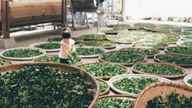Sri Lanka’s tea growers have gone organic
Until quite recently, Sri Lanka had disappeared from the British tea connoisseur’s map. While European tea lovers have always rated top Ceylon estates highly, here the 60s Ceylon Tea centres – which served up a cup of heartburn-inducing tannic brew alongside some vaguely curried veg in cold pastry – did nothing to endear it to consumers. During the same period, UK tea brokers deserted Sri Lanka as the industry was nationalised, quality took a nosedive and the colonial planters either headed for home or for Kenya. To cap all that, the island’s extensive tea plantations were hit by an outbreak of worms that were resistant to pesticides: a frightening development, as a similar outbreak had wiped out Ceylon’s coffee production in perpetuity. A one-off, low-tech solution was found: children were paid manually to pick off the worms from the leaves.
This salutary demonstration of the limitations of pesticides, however, set Sri Lanka on a course that is now making the country’s teas some of the most exciting in the world. Since the crisis, the national policy has been to use pesticides only in extremis , never preventatively, and to encourage beneficial insect species as a mechanism for predator control. In the past few years, as the government has introduced the partial re-privatisation of the tea plantations, some of the best estates have taken pesticide-avoidance to its logical conclusion and converted to organic. And not just any old organic: many have adopted the most rigorous and sophisticated type of organic production possible, the biodynamic method of the Austrian philosopher, Rudolf Steiner.
Steiner advocated the use of natural „preparations“ (of which more below) and a lunar calendar to plot the optimum time for all operations in the growing cycle. Like homeopathy, the Steiner approach was once widely mocked as cranky mumbo jumbo, but today – and although the science behind it is still not fully understood – it is increasingly accepted that his methods can achieve remarkable results.
The application of these biodynamic methods to Sri Lanka’s tea production would have passed me by were it not for the efforts of Robert Wilson, a retired Ceylon tea planter, who is now importing into the UK a fabulous portfolio of „Ceylon“ Teas – both organic and conventional – from top estates such as Brunswick, St James and Mahagastotte. Wilson’s teas are bought in the most desirable dry season, when they are, in Ceylon tea-speak, at their most „flavoury“.
One of the most exceptional comes from the biodynamic Iddalgashinna Estate, which sits 6,500ft up in the Beragala Hills of Uva, and whose presence is announced at the lower levels with whitewashed road signs that declare the area a „Toxic-Free Zone“. Iddalgashinna’s natural environment shares much with the virgin rainforest on which it borders – superficially, it looks like a beautiful green jumble. While many tea plantations consist of concentric lines of tea bushes, here they are interspersed with diverse trees and plants, which produce not only vital shade but also beneficial green manures that are then supplemented with worm compost.
The only spray the tea bushes get is a Steiner-style „preparation“. Fresh dung from a lactating cow is mixed with rock phosphate and crushed eggshell, then packed into shallow brick trenches, covered with sacking and left for 30 days. The resultant mixture is then turned with a fork and left for a further 30 days, before being mixed with water and sprayed on the tea bushes. It has proven a remarkably effective alternative to pesticides, and aids the production of teas of supreme quality.
I worked my way through all of Iddalgashinna’s tea grades. The tea, which is always hand-picked, is manufactured in the traditional, skilled, „orthodox“ manner. Among the stars on parade was a green orange pekoe that would cause a stampede of Japan’s most devoted tea collectors – its large leaf unfurls beautifully on infusion, producing a pale-green liquor with an ultra-fresh, cut-grass bouquet and distinct peatiness – while even the most committed, first-flush Darjeeling lover would be left weak-kneed by „silvery tips“, the newest growth, which produces a light, subtly smoky liquor. The other large-leaf black grades on offer are amazing, too, with pleasant bitterness and a nose of freshly-peeled oranges, caramel and cut flowers.
And yet Iddalgashinna is not some inconsequential little tea garden. This „bio-tea“ estate has a workforce of 1,400 and production to match. It is currently owned by a local company, has its own nursery school, house-building schemes and no less than three medical centres. This kind of infrastructure is standard in the traditional plantation system, but here the ethos is more egalitarian. On most estates, the workers stay respectfully outside the manager’s office window. At Iddalgashinna, they are inside, working out the plantation’s transition to community ownership.
Many of Wilson’s other Ceylon teas have an equally fascinating pedigree, and the sheer selection is paradise for anyone who likes to explore the intriguing nuances of a fine specialist product. Like malt whiskies, each estate has a unique style, as does each district, from the pungent, almost astringent Nuwara Eliyas to the more mellow Dimbulas or the delicate Uvas. Just one word of warning, however: dip your nose into these amazing teas and expect to get hooked.






